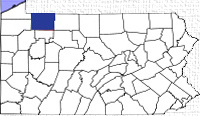THIS township was formed from Kinzua, on the 7th of June, 1833. Its
territory occupies the entire southeastern corner of Warren county, and
is bounded north by Kinzua and Mead townships, east by McKean county,
south by Forest county, and west by the township of Cherry Grove. It is
very regular in outline, the northern boundary being the only one that deviates
from a straight unbroken Hne. The land is drained by Tionesta Creek
and its tributaries, and other small streams. This township, with Mead and
Cherry Grove, was originally included in the limits of Kinzua township. The
first town meeting after the town was set off from Kinzua was of a most primitive
description. There were but seven men present at the meeting, which was
held on the old farm of Timothy Barnes. Their bench consisted of a bob-sled
turned upside down. There were not men enough present to fill all the offices,
and those who were there merely agreed upon the persons who should perform
certain duties, and thus sent in their report. According to the accurate memory
of Erastus Barnes, the names of these seven were as follows: Timothy
Barnes, and Erastus Barnes, Samuel Williamson, Stephen Taylor,
John Williamson,John Brown, John Gilson. The only families in town at that
time were those of Timothy Barnes and John Gilson.
Early Settlers.—The first tax list for Sheffield, completed in 1834, reveals
the names of thirty-three property owners in the township, not more than
twenty of whom were permanent residents. Several of them were mere squatters,
who "folded their tents " and departed upon the slightest occasion, while
others were men of prominence elsewhere, who in their speculative reach had
taken hold of land or other property in this vicinity. The list is as follows:
James Arnett, 225 acres; Richard Dunham, 225 acres and a saw-mill;
Timothy Barnes, 225 acres and a saw-mill; Asahel Kidder, 225 acres; Henry
Snapp, 225; Melchi Snapp, 225; George Jones, 165; David Mead, 445 acres
and two saw-mills; Thaddeus Mead, C. Mastin, 850 acres and a saw-mill;
John Ingoldsby (Inglesby), John Williamson, 112 acres; Samuel Williams, on
220 acres ; Silas Lacy, 450 acres; Nathan Lacy, 650 acres and a saw-mill;
Patterson Lacy, Jeremiah Lane, 50 acres; Stephen Taylor, John Brown, Orrin
Stanton, 225 acres; Joseph Carver, Stephen Carver, John Gilson, 225
acres; William Barton, Cabot Barlow, James Stedman, Christopher Stranger,
Daniel Stranger, Lorenzo Mason, James Scott, James Gaty, Henry Snapp, jr.,
Archibald Tanner. The last named—whom everybody knows to have been a
prominent resident of Warren—was taxed for 450 acres of land. In the above
list we have not mentioned the personal property for which these persons were
assessed, deeming it sufficient to state the amount of their real possessions.
Below are given a few facts concerning the more prominent of these early
settlers.
James Arnett lived in the northern part of the township, as it was then
constituted, a little above the present Stoneham. Arnett's Run derived its
name from him. He was one of the earliest of the settlers in that part of the
town. He remained there but a few years, however, before removing to the
West.
Richard Dunham was one of the most prominent men ever in Sheffield
township. He died on the 30th of January, 1870, aged sixty-seven years six
months and twenty-two days. More particular mention is made of him in the
sketch of M. B. Dunham, appearing in later pages. In May, 1832, he with
his wife and infant child, in company with the now venerable Adam L. Pratt,
crossed the Allegheny River at Shipman's Eddy, assisted by Mathew Morrison.
The crossing was made with two large canoes lashed together, on which was
a platform of boards. On this were transported the goods, while Dunham's
cow and oxen swam the river behind the catamaran. The river being high,
involved the party in considerable danger. On the south side of the river
they met with John Inglesby, who had previously settled in the dense forests
of what is now Cherry Grove township, but had become disheartened and
moved out again. Dunham employed him as a guide in this wilderness. Their
road lay over the top of the mountain northwest of the site of the Stoneham
tannery, near which was a small log house occupied by a Mr. Brown, who had
about an acre of land partly cleared. Here the party took dinner. The road
has been described by Mr. Pratt as being little more than a trail, the underbrush
cut off, and the logs turned to one side far enough to let a sled pass.
In many places they were compelled to widen the road in order that their
wagon, the first one that had been over the ground, could pass. Night overtook
them at what was called the " Blacksley Chopping," about three miles
southwest of the present site of the Clarendon tannery, where there was a
chopping of two or three acres, without a clearing or a house. A shelter was
improvised of hemlock boughs, in which the party passed a comfortable night.
The next day they came to the house of Inglesby, about half a mile from the
present residence of Montgomery Farnsworth, in the township of Cherry
Grove. They remained there several weeks, meantime repairing an old cabin
on Dunham's land, about a mile north of the Inglesby tract. In June they
removed to this cabin, chopped and cleared ten acres, sowed it in wheat and
had an excellent crop in the ensuing season. In 1833 Richard Dunham left
his place in Cherry Grove and engaged in lumbering a short distance north of
the present village of Sheffield. He was an energetic and public spirited citizen,
through whose influence it was chiefly that the township was organized
and schools started. In his later days he removed to Warren, where his wife
still resides with their son, M. B. Dunham.
Timothy Barnes has been justly styled the pioneer of Sheffield township.
He was born on the 4th of October, 1786, and died on the 10th of October,
1878. As early as 1828 he emigrated from Italy Hill, Yates county, N. Y.,
and built the first saw-mill on the south branch of the Tionesta Creek. His
house was about half a mile south of where E. Barnes now lives. This mill he
operated about two years, and then sold to Nathan E. Lacy. On the 4th of
July, 1832, he raised another saw-mill on the site of the one now owned and
operated by his son, Erastus Barnes, at Lower Sheffield. It was then closely
surrounded by a forest of lofty pines, which stood like serried ranks of grim
and silent sentinels, frowning-upon the intrusion of civilization. One of these
trees, to drop the simile, at the height of eight feet from the ground, measured
twenty-three feet in circumference; another made seventeen saw-logs sixteen
feet in length. When he first came to his wilderness home, he came from
Warren, and was obliged to cut his own roads. The journey of fourteen miles
was accomplished in four days. About thirty-five years ago Erastus Barnes
built the grist-mill near the old saw-mill, which was the first and only gristmill
in town. Timothy Barnes was characterized by his charity and benevolence
— a twofold quality which seems to have been inherited by his son,
Erastus Barnes. "In the early settlements," Mr. Pratt has written, "food and
provisions were often scarce, but Barnes permitted no one to want for either
food or work—he was the 'mainstay' of the whole country. He spent the
evening of his days with his son Erastus at the old homestead, surrounded by
his children and in the enjoyment of all the comforts merited by a well-spent
life."
It is related that the next winter after Timothy Barnes built his mill he
went back for his family in the State of New York, while Erastus hired out to
work in a mill at Warren. During the winter Erastus came back to see how
the men who worked in his father's mill were improving their time, and how
they prospered. He made his way through the woods on foot and alone, and
was followed the entire distance by wolves. The men he found had gone
hunting and left nothing to eat in the shanty but a few spoonfuls of buckwheat
and a small piece of venison. Of this young Barnes made a partial meal and
passed the night alone in this rude hut, with the hungry wolves howling about
his ears in an ominous manner. On his return to Warren the next day, he
found the wolves had returned before him.
Asahel Kidder cleared a farm two miles west of Sheffield Station. After a
residence there of eight or ten years' duration he removed to Jackson Run,
two miles north of Warren. His old farm is now used in the production of
oil. He left no descendants in this town, though he has one son, Nathan, in
North Warren.
Henry Snapp was a farmer who lived about half a mile north of Sheffield
Station, where he remained until his death. He has several descendants in
town now. His son Melchi (who died October 12, 1882, aged about seventy nine
years) had charge of the farm in later years. They settled there in 1832.
William and John Snapp, now respected residents of this township, are sons
of Melchi. George Jones, an eccentric character, who was accustomed to
calling on his neighbors for "victuals," of which he devoured inordinate quantities,
and who was known as "Brother Jones," because he styled all his woman
friends as "Sisters," lived about two miles west of Sheffield Station for a few
years, and then left for parts unknown.
David Mead, a shrewd seeker after wealth, lived on the southern line of
the township, his house standing partly in one town and partly in another.
It is related as a fact that when a sheriff from Warren county came for his arrest,
he would invariably be found on the Forest county side, and vice versa.
He had a saw-mill at this place. Some thirty years ago he removed to Warrenton,
O., where he was soon after drowned while attempting to cross the
Ohio River in a skiff. Thaddeus Mead was a brother of David, who never
had a fixed residence in town.
C. C. Mastin was a wealthy man, who came to Warren from Yates county,
N. Y., but who never lived in Sheffield. He built a large mill three miles below
the forks in the south part of the town, now owned by Frank Henry, and
which, it is said, has manufactured more lumber than any other mill in Sheffield.
We have already learned something concerning John Inglesby. He operated
the Mastin mill for a number of years and then moved away. None of
his descendants now live in town.
John Williamson, a bachelor, operated the David Mead mill for a time. He
was here but six or eight years. A singular circumstance was that there were
five brothers of them—Samuel, John, Nathan, and two others whose names
are not remembered—who all lived bachelor lives and kept bachelor's hall.
Silas Lacy was born at Bound Brook, N. J., on the 30th day of March,
1789, and died at Warren on the 27th of December, 1870. Few men of any
country have lived a more virtuous, consistent, and faultless life than he. At
the early age of twenty years he became a member of the Presbyterian Church
of his native place, and was soon after elevated, by virtue of his pious zeal, to
the position of ruling elder. In 1816 he removed to Yates county, N. Y., where
he was again promoted to the position of elder. He came to Warren county in
1828, and became one of the pioneers in the roadless and unbroken forest of Sheffield
township. After enduring privations of cabin life and aiding his brother,
Nathan E., in the operation of his mill in Sheffield for seven years, he went to
Warren to pass the remainder of his life. There he resumed and for years engaged
in the business to which he had been trained—that of a hatter. Previous
to his coming to Warren it had been his custom to take part in religious services
in Sheffield, and often also walked to Warren to church on the Sabbath. Three
years before leaving Sheffield he was elected an elder in the Presbyterian
Church of Warren. This office he held by successive re-elections until his
death. In February, 1809, he married Nancy Parker, of New Jersey, who
survived him two years. They had eleven children, only one of whom is deceased.
One of the daughters is now the wife of Peter McKinney, of Pittsfield
township.
Jeremiah Lane settled on the farm next south of the present residence of
Erastus Barnes, and built the house which stands there to this day. He married
a daughter of Deacon Silas Lacy, and now lives in Jamestown, N. Y., a
very old man. He went there at least thirty-five years ago. Not far from the
year 1840 he built a saw-mill on the east branch of the Tionesta, which has
long since disappeared, and the site of which is now a part of an oil field.
Stephen Taylor was born December 4, 1796, and at the time of his residence
in Sheffield, a single man, worked out for Timothy Barnes, and afterward
for Erastus Barnes. He it was who came first with Timothy Barnes and
helped to cut the roads through the forest. He also built the mill. At a later
day he was the mail carrier for this part of the country. He finally married,
and on the 13th of August, 1878, died at the home of his son, Neri, in Forest
county. He was a soldier of the War of 1812.
John Brown, the father of the famous ornamental penman, Delavan Brown,
who was born in Sheffield, came to the town to reside on the west bank of the
Tionesta in 1832, the year in which the tide of immigration in early days had
reached the flood. He afterward moved to Chautauqua county, N. Y., where
he died.
Orrin L. Stanton settled about the same time about on the present site of
Barnes Station, in Lower Sheffield, where he kept the first store and the first
post-office in town. The Warren and Ridgeway turnpike was built by the State,
and commenced in the summer 1832. Orrin Stanton built the first section of
it, from the summit north of Stoneham to the river, and it was probably this
business which brought to his notice the desirability of living in this fertile
region. It is said that for a time he kept the little hotel in Warren which
stood on the site of the present Carver House. He afterward removed to
Smethport and thence to Kinzua, where he now has relatives and descendants.
While he was postmaster the mail was carried once a week between Warren
and Ridgeway, and his brother, Daniel Stanton, was the carrier.
Joseph Carver operated the mill of Timothy Barnes, and rented it a year
or two. Stephen Carver was his brother and partner in the mill. After a
residence here of two or three years they removed to Warren. Stephen Carver
built and named the Carver House in that place.
John Gilson was one of the most prominent men that have figured in the
history of Sheffield. He was born on the 20th of May, 1797, and died June
17, 1884. During his residence in this township he lived on the site of Gilson
Station, which derived its name from his descendants. His widow still resides
in town. Four sons also live here, Rufus, Curtis, James, and John. Carver
Gilson, another son, named after the Carver family, now lives near Fredonia,
N. Y. One who is in every way competent to state the facts, writes thus concerning
the life in this county of the subject of this notice :
"John Gilson, sr., brought his family on a raft from Olean to Warren the
day John, jr., was six years old. (This must have been on May 20, 1803.)
They lived in an old storehouse that stood where the Carver House now
stands, until they put up a log house — one of the first families to settle in
Warren. John was about fourteen years old when his father died, leaving him
and his sisters to support their mother, who died four or five years later, and
was the first person buried in Warren. The father was buried about three
miles up the Conewango Creek. John, jr., was the youngest of a family of
ten children. While he was supporting his mother he worked for a man by
the name of Reese (who lived three miles below Warren) twenty-one days for
a barrel of flour, cutting cord wood at the rate of four cords a day. The place
now called Sheffield was then called ' Forks of Tionesta,' and he helped to
run the lands through the region for miles around. He was then about sixteen
years old. He was with Colonel Dale, surveying, who advised and helped
him to buy the lot 358, which was covered with fine pine timber. He made
his home in Warren most of the time. He followed the river, rafting, canoeing,
and boating, until he was thirty years old. There is not a mile of the
river bank between Warren and Pittsburgh that he has not slept on in his
trips. He began work at the ' Forks' in January, 1820. He chopped about
an acre, and put up a plank house twelve feet by sixteen in dimensions. On
the 10th of February he married and came to live in this house the same
week, making the journey with horses and sleighs on the ice, there being no
roads. In April he went to Franklin to buy a yoke of oxen, and brought
back seed potatoes and oats on a sled. From lack of roads his progress was
slow, and he was overtaken by night in the forest. Wolves and owls were his
company. He was gone just a week, while his young wife was left alone all
that time. The only family living within ten miles of his home was that of
Mr. Barnes, who had moved here just a week before. Asa Barnes, aged about
sixteen years, stayed in the house with her nights, while she passed much of
her time during the long days listening to the twittering of winter birds, and
fishing. She caught many a trout weighing a pound and a pound and a half.
The wolves kept up their howling about every night. When Mr. Gilson
reached home he set about clearing his land, after doing which he was at a
loss for a drag. He finally succeeded in constructing one, teeth and all of
wood. When the oxen first began to draw the drag, it caught for a second on
some roots, and then bounded against the oxen's heels, which ran as if for life.
John came in the house laughing, and said he thought his oxen were pos-
sessed of the evil spirit. The first year he raised turnips, potatoes, and oats
enough to keep a yoke of cattle and a cow. Winters he passed in cutting
square timber and running it down the Tionesta, while he passed his summers
in clearing and cultivating land. There was about here a great amount of
land sold for taxes, several lots of which he bid off for the sake of the timber.
In 1844 he built a saw-mill and ran his lumber to Pittsburgh, Cincinnati, and
Louisville, supporting his family in this manner until 1865, when he sold out
all but the improved lands. These he divided between three sons who were
married, and took the rest of the family to Fredonia, Chautauqua county, N.
Y., where he bought a farm. He stayed there fourteen years, and was then
compelled, on account of poor health, to return to his old home in Sheffield,
where he bought half an acre of land and built himself a house. He buried
five children in the Sheffield cemetery. Electa died at the age of six years,
Sarah at the age of two, John H. at ten, Gilbert at two, while George S.
enlisted in the War of the Rebellion and was killed at the battle of Gaines's
Mills, when twenty years of age."
The above paragraphs were taken from an interesting letter from Mrs. Gilson,
the widow of the subject of this notice, who also writes: " When we first
moved here to the ' Forks ' of the Tionesta Creek, our house stood near the
bank of the creek. There was a plenty of wild game at that time. We could
very often see deer swimming in the creek. John could kill one almost any
time. We frequently saw them feeding with the cattle. There were also
wolves and bears in abundance. He killed several bears, and caught several
wolves in steel traps, for the scalps of each one of which he received a bounty
of twelve dollars.
"We had visitors every fall. The Indians, who came every fall to hunt,
camped around us. I often went to see them in their camps, and buy baskets.
The first fall after we came here I saw wild turkey tracks in the first snow that
fell; they were quite near the house; I told John I thought I could catch
one with a trap, and accordingly set one baited with oats. The next morning
I heard the chains rattling, and on going to the trap found a fine fat turkey
struggling for liberty; I broke his neck with a stick. After the Warren and
Ridgeway turnpike was opened we built a new house, back on the road, large
enough for a hotel. One day, while the men were at work on the house, a
deer came swimming up the creek. I seized a gun, and resting it on a pile of
boards, shot and killed it. The men dressed it. That night we heard a mournful
howling down the creek. John set a steel trap next morning, baited with
the deer's head, and we soon caught a wolf. We supposed that the wolves
had driven the deer down the river. At that time there was no store nor grocery
nearer than Warren. As soon as the road was finished the farmers from
the State of New York began teaming through here, and carried everything
from a spool of thread to a barrel of flour. We could buy everything we
wanted of them. They carried provisions to the iron country and came back
loaded with iron. After a time we commenced keeping hotel and post-office,
remaining in the hotel twelve or fourteen years." 1
| 1 Although this letter was not written to be published verbatim, it contained so vivid a description
of the mode of living in those pioneer times, that we could not refrain from publishing it in almost the
form in which it was written. |
James T. Osgood was born in Rockingham county, N. H., on the 10th of
October, 1808. He is a descendant of William Osgood, one of three brothers
who came from England in 1636 and settled in Southern New Hampshire.
Chase Osgood, father of James, settled still farther in the interior. James Osgood
came to Sheffield township in 1848, and has been one of the justices of
the peace in town for the last thirty-three consecutive years. His business for
the first few years in Sheffield was shoemaking. In February, 1832, he married
Jane, a daughter of Jacob Cole, of Sussex county, N. J., who is living yet.
They have had ten children, six of whom, four daughters and two sons, are
still living. Both sons, Chase and Henry, were in the army during the last
war. When he came here in 1848 the surface of the township was covered
almost entirely with a dense growth of pine, mingled with considerable hemlock
timber. The lumber business was then at about its most active period.
It lasted with almost equal activity until about 1860, and since then has somewhat
declined, though it is even now by no means extinct. The pine was
about all gone, however, by the close of the last war.
In the winter of 1864, after J. F. Schoellkopf, of Buffalo, had purchased
some land of Daniel D. Bowers and of John Gilson, an oil excitement was
created, and all the rest of the property about where the village of Sheffield
now stands was sold for the purpose of producing oil. Lands of Elias Kingsley,
Elihu Kingsley, John Russell, Stephen Andrews, Captain Wallace, and
James T. Osgood were sold to non-residents, who intended to drill for oil.
Drilling was done, but by reason of the ignorance then prevailing concerning
the proper method of testing, no oil was discovered, and the lands which had
so recently enriched the vendors and impoverished the vendees, were sold for
nominal prices or for taxes. This was in the winter of 1865. No paying well
was drilled until 1881, when the firm of Crary, Sigel & Co., consisting of
Walter Horton, Jerry Crary, and Charles Sigel as members, associated with
James Magee, of Warren, started a well with a production of about fifty barrels
a day, which is still producing about five barrels a day. There are now
eleven wells on what is known as the Donaldson farm, and twenty-three wells
on adjoining lands. Other oil firms here now are Melvin, Walker & Howe,
Clark & Armor, the Union Oil Company, and many others. The first gas
was struck by W. W. Hague, of Tidioute, in 1875 on lands of Horton, Crary
& Co. The same well now furnishes the town with gas and has shown no
diminution since the end of the first six months. Among many private gas
wells may be mentioned those of Erastus Barnes and Mrs. L. M. Barnes.
It will be seen that these various industries, coupled with the extensive
tanning business which will soon be mentioned more at length, have conspired
to keep the agricultural resources of the township from emerging from their
rudimentary state. The soil of the town is well adapted for some kinds of
farming, especially the raising of grain and fruit, but not particularly fitted for
dairying. The lowlands are composed of a sandy loam, and the uplands of a
gravelly clay. The decline of the lumber interest has conduced to develop an
interest in the agricultural possibilities of the town, and farming has become
one of the infant industries of the region.
Municipal History. — Contrary to the natural supposition of a strange visitor
to. the township, the fact is that the little settlement called Lower Sheffield,
at Barnes Station, is by far the oldest village in the township, and was indeed
looked upon as the only village in the town for many years before it conceived
the probability of having the present Sheffield village for a rival. It
was here that Stanton first sold goods, and that Gilson first kept tavern. In
1839 John Gilson built this tavern, which, after twelve or fourteen years, went
into the hands of George Messenger. His successors have been Nathan Branch,
to 1850; Asa H. Barnes until 1868 ; various lessees under Asa Barnes until
1876; Erastus Barnes has since owned and rented it. The present lessee is
James Marley.
It was here, too, as we have seen, that the first mills in town — those of
Timothy Barnes—were built. In 1850 Erastus Barnes started a store opposite
his present residence. He drew his goods by team from Dunkirk. This
store was kept open for ten years. The only store now kept here is that of
J. E. Berkheimer, who has been here since 1881, and who carries stock worth
about $3,000. (At the present writing it is learned that Mr. Berkheimer is
now closing his store.) About five years ago Selkirk Newell, of Syracuse, N.Y.,
took a contract from Erastus Barnes for ten acres of land, on which he
proposed to drill for oil. Instead of finding oil he found large quantities of
gas. Nolan & Boardman, from New York State, then purchased four acres
of Mr. Barnes for the manufacture of lamp-black. They erected a long iron
building for this purpose, and have now demonstrated the success of their
scheme of converting the gas into lamp-black of a superior quality. These,
with the mills of Erastus Barnes, constitute the present business interests of
Lower Sheffield.
| Sheffield in 1895 |
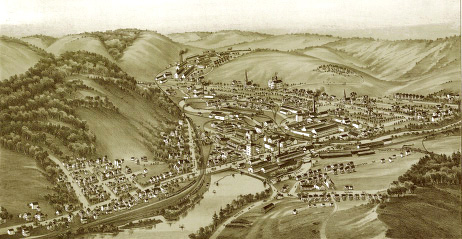 |
| Published by Thaddeus Mortimer Fowler & James B. Moyer in 1895, this panorama was also drawn by Thaddeus Mortimer Fowler. |
The village of Sheffield owes its origin and growth to the enterprise of the
several firms now engaged in the extensive tanneries of the place. From about
1836 to 1864 the land, or the larger part of it, now embraced within the
limits of Sheffield village, was owned by Daniel D. Bowers, a native of Vermont,
who, soon after the latter date, removed to Missouri and there died.
In 1864 W. & W. Horton purchased his land, and three years later the firm
of Horton, Crary & Co. was formed and built one tannery. In 1871 J. McNair
& Co. bought the land and saw-mills of I. V. Stone, and in 1878 built a tannery
on the site, in which Horton, Crary & Co. have a controlling interest.
About the time of the building of the tannery first above mentioned, J. F.
Schoellkopf, of Buffalo, built a tannery here, in which Horton, Crary & Co.
have also obtained a controlling interest. Horton, Crary & Co. have also three
saw-mills in the village, and produce large quantities of lumber. Their income
from the production of sole leather amounts to some $2,500,000 per annum.
They are further largely interested in the production of oil, having wells in
this township—at Henry's Mills, at Donaldson's, and near Farnsworth's Siding
—which altogether produce about 18,000 barrels a month. This village is
also the center of the great gas-producing district, in which Horton, Crary &
Co. have extensive interests. This firm own land in this and adjoining counties,
for their varied interests, amounting to about 50,000 acres. They built the
Tionesta Valley Railroad in 1881, and afterward bought out the Cherry Grove
and Garfield Railroad, which was built by an eastern company. The members
of this company are Webb Horton, H. H. Crary, Walter Horton, Jerry
Crary, George Horton, Isaac Horton, and George Dickinson. They employ
nearly or quite 3,000 hands, most of whom are Swedes and Germans, and reside
in this village. The members of the firm of Schoellkopf, Horton & Co.
are J. F. Schoellkopf, sr., Charles Sigel, and Horton, Crary & Co. The members
of the firm of John McNair & Co. are John McNair, C. W. R. Radeker,
and Horton, Crary & Co. The principal part of the business done by this enterprising
firm of Horton Crary & Co. is export trade. They manufacture
nothing but hemlock sole leather. The hides are almost entirely from South
America. Of course the chief motive which induced them to locate here was
the dense growth of hemlock in the forests. To their industrious energy, and
that of their neighboring companies, is due the thrift and growth of the village
of Sheffield.1.
| 1. The Donaldson tract, before mentioned, embraces the land once owned by Andrew Donaldson in the southern part of the township. He was a farmer and lumberman, and came here about 1845. His widow now occupies a part of the old farm. He died August 17, 1867, aged sixty-six years. |
Undated postcard with caption:
Road to Barnes - Horton Residence, Sheffield, Pa. |
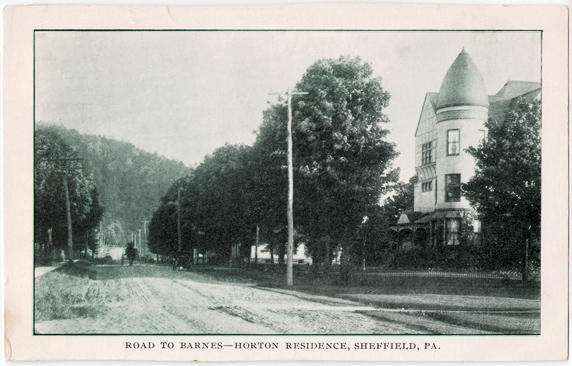 |
| Postcard image courtesy of Warren County Historical Society, Warren, Pa. |
The Horton family came here from Sullivan county, N. Y. They are descended
from Barnabas Horton, who came to this country from England in
1632, in the good ship Swallow, and settled on Long Island. H. H. Crary,
and indeed all the members of the firm of Horton, Crary & Co., except George
Dickinson, are natives of Sullivan county, N. Y. Mr. Dickinson is from Delaware
county, N. Y.
Daniel D. Bowers, mentioned above, was born in Vermont, it is said, about
1803, and came to Sheffield not far from 1836. He settled about on the site
of the present house of Webb Horton, and, besides operating a saw-mill, kept
a tavern there under the name of the Forest House until about 1867. The
house was then converted into a boarding-house for the employees of the tanning
company, and thus used it burned about 1879.
About the time that Horton, Crary & Co. came to Sheffield, Amos Lee,
a quondam butcher and cattle dealer, also arrived, and about 1869 built the
Lee House, which he kept until his death, in 1875. In 1873 he enlarged it.
During his life it was a temperance house. The next proprietor was Charles
Lamkin, who did not own the property, however, and who gave place in 1884
to the present proprietor and owner, Joseph Clinton. It is now one of the best
of hotels. It has about thirty rooms, and is unusually spacious and convenient,
as it was erected apparently for the benefit of families rather than transient
individuals.
| Undated postcard showing the Lee House, Sheffield |
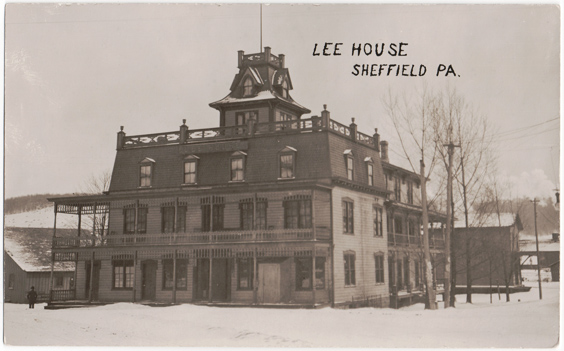 |
| Postcard image courtesy of Warren County Historical Society, Warren, Pa. |
The mercantile history of the village of Sheffield also properly begins at
the year 1864. W. & W. Horton then started a store in connection with
their other business, and in the following year put up the block that now faces
the railroad. At that time Chase Osgood was keeping a store at Lower
Shef
field. In 1867 Horton, Crary & Co. succeeded W. & W. Horton. They now
carry stock valued by one of their firm at $175,000 in all the departments.
They have stores in three separate blocks, and deal in all kinds of goods, groceries,
dry goods and furnishing goods, furniture, hardware, boots and shoes,
drugs, etc. E. L. Branch also began to deal in groceries about ten years ago,
and in the spring of 1886 took into partnership Orris Hall. Morris Einstein
deals in general merchandise, and has been in buiness here about eight years.
F. D. Austin has dealt in groceries about six years. The clothing store of
Levi Epstein is about two years of age. Hull & Siegfried have traded in drugs
since the spring of 1885; Frank Johnson & Brother in groceries since the
spring of 1886.
The planing and saw-mill of George R. Wood has been under the proprietorship
of Mr. Wood about ten years. It was formerly operated by Wood
& Culbertson.
In June, 1885, an opera-house was opened by a stock company, who had
built it, and promised to be a thing of profit and pleasure to the citizens.
The cost of building it has been stated to the writer to have been about
$12,000. In May, 1886, this building burned.
Post-offices.—The first post-office in town was at Lower Sheffield, though:
it was established by the appointment of Orrin Stanton, about 1834 or 1835,.
under the name of Sheffield. About 1841 John Gilson was appointed, and
had the office several years at his house. George Messenger succeeded hirm
James T. Osgood then held the office until 1853, when he was elected justice
of the peace, and was succeeded in the post-office by Asa H. Barnes. After
several years he had Mr. Osgood appointed his deputy, and requested him to
keep the office. In 1873 Erastus Barnes was appointed postmaster, though
since his appointment Mr. Osgood has continued to act in his stead. For
some years previous to 1864 an office had been opened at Dunham's, called
West Sheffield, and presided over by Richard Dunham. The Philadelphia and
Erie Railroad was opened in the winter of 1865, and in the following year the
office of West Sheffield was discontinued and re-established as Sheffield (while
the old Sheffield office was changed to Barnes), with Webb Horton as postmaster.
In 1868 Jerry Crary was appointed postmaster at this point, and has
ever since continued in this office.
Schools and Churches.—The present school-house at Barnes Station was
built in 1883. On this site, about 1840, Erastus Barnes and John Gilson built
a school-house. The first school in town was taught in this part of the town
in 1833, by Miss Milford. The next was taught by Leverett Barnes. In the
spring of 1835 Richard Dunham, Melchi Snapp, and Adam L Pratt built a
school-house in the woods near the spot where Mr. Armstrong's barn now
stands. ' There Miss Hannah Snapp taught the ensuing year, and the winter
terms of 1834 and 1835 were taught by Adam L. Pratt. About 1852 or 1853
the township built a larger school-house on the site of the one formerly erected
by Barnes and Gilson, and which is now used as a union church in Lower
Sheffield, though it has been removed from its old site. In this school are
now in attendance about one hundred pupils. There are now in the entire
township about six separate schools, two in the Farnsworth neighborhood, one
in the western part of the town, one at Barnes, one near Frank Henry's mill,
and the graded school at Sheffield village, which was built in 1876, burned in
1877, and immediately rebuilt, having been fully insured. It has five departments.
Its average attendance is stated to be about 250. The principal is M. A. Rigg.
| Two postcards of the High School in Sheffield |
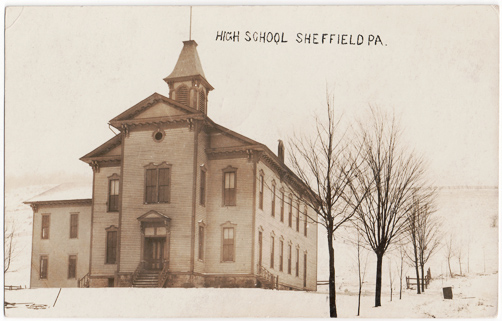 |
| Postcard image courtesy of Warren County Historical Society, Warren, Pa. |
| |
| Postcard dated August 4, 1913 by the sender, Emma D. Gillespie. |
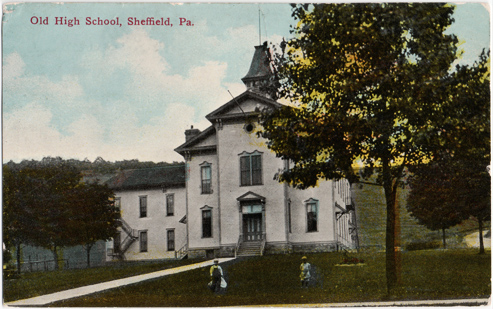 |
| Postcard image courtesy of Warren County Historical Society, Warren, Pa. |
The first organized church in town was of the Methodist Episcopal denomination,
and was formed in the Barnes neighborhood about fifty years ago.
Erastus Barnes, though not a member of any denomination, recognized the
desirability of having a church in the town, and obtained a good subscription
list, which he headed himself. Silas Lacy, Jeremiah Lane, Melchi Snapp, and
Richard Dunham were also very prominent and active in its organization and
support. Rev. Halleck preached the first year, while residing in Warren.
Services were held once in four weeks in the school-house. About three years
ago a Free Methodist Church was organized here, and a house of worship was
erected in the summer of 1886. The pastor is Rev. Mr. Gaines.
The first church to be built in Sheffield village was the Methodist Episcopal,
which was erected in 1867, and burned in the winter of 1876-77. It was
originally built through the efforts of Richard Dunham and Horton, Crary &
Co. After the fire, the firm just named rebuilt it at once at a cost of about
$7,000, and presented it to the Methodist denomination. The present pastor
is Rev. Mr. Darling. About 1877 the Roman Catholics built a church here,
which is attended by Father de la Roque, of Warren. There is a Free Methodist
Church also at Farnsworth's.
The Evangelical Lutheran Bethania Church (Swedish), located at Sheffield
village, was permanently organized in 1882. The first meeting was held on
the 30th of June, 1882, in the private house of John Monson. Rev. T. Franyen,
of Kane, presided, and Rev. N. G. Johnson, of Warren, acted as secretary.
The original members were J. A. Anundson, John Monson, J. P. Gustafson,
Eric Peterson, Olof Peterson, C. G. Bergman, Otto Lagerquist, James
Christiansen, T. A. Rydeberg, Andrew Wermblad, and Carl Otto Lang. The
church edifice was erected in 1883 at a cost of about $2,500—framed. The
first pastor was Rev. J. A. Rinell, for 1883 and 1884. At present the congregation
is under the care of R. A. Thompson, a student of Aug. College and
Theological Seminary, of Rock Island, Ill. The present membership of this
church numbers sixty, while the church property is valued at about $3,000.
|



